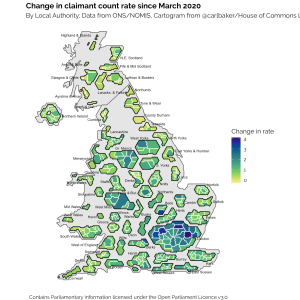April 2022
1. The cost of living is outpacing wages, and benefits have risen far less than inflation
The latest data show average regular earnings grew by 4.1 % in the year to February 2022, though end of year bonuses for some pushed headline earnings growth up by 5.4 %. With the Consumer Price Index rising by 6.2 % in the year to February 2022, this means that real regular earnings have fallen over the year. In the month of February, regular pay in real terms fell by -1.3%, the largest single month fall since December 2013.
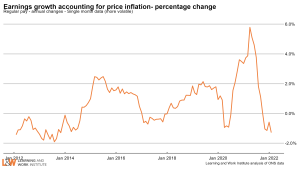
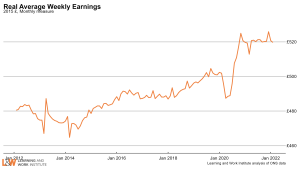
The cost of living crisis is likely to deepen in the months ahead with inflation set to rise further, energy prices increasing along with National Insurance – although the increase in the national insurance threshold and reduction in Universal Credit taper rate are welcome.
Universal Credit was uprated by 3.1% in April, far lower than inflation, meaning those with the fewest means are being hit the hardest. The Government needs to respond by increasing Universal Credit as part of a broader plan to tackle the cost of living.
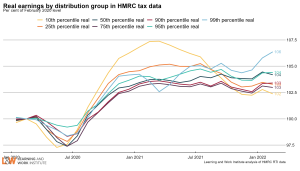
2. Labour market recovery has slowed, with employment still 588,000 lower than pre-pandemic driven by rises in economic inactivity
Employment rose by 10,000 in December to February 2022 compared to the previous quarter but remains 588,000 lower than before the pandemic. The timelier but less comprehensive measure of PAYE employees increased by 35,000 in March 2022 compared to the previous month and is 544,000 above its pre-pandemic level. Unemployment fell by a further 86,000, but economic inactivity has risen and is now 487,000 higher than pre-pandemic.
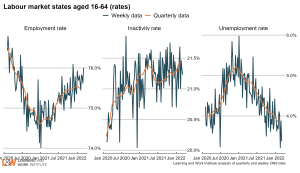
The number of vacancies in the ONS vacancy survey remains at record levels. The number of online postings from ONS and Adzuna is 37% above the February 2020 level (seasonally adjusted). Compared with the same week in 2018, the overall vacancy level is up 16%.
3. There are fewer potential workers for employers to recruit
Our analysis shows there are around 1.25 million fewer economically active people (either employed or unemployed) than if pre-pandemic trends had continued. Around one third is the result of a lower population, two thirds due to people stopping looking for work (growth in economic inactivity). This helps to explain the difficulty some employers are reporting in filling vacancies – there are fewer people looking for or available for work. This isn’t just bad for business, it’s detrimental to people who would like to work but are dropping out of the workforce prematurely.
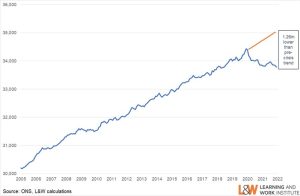
The biggest rises in economic inactivity most recently have been among those aged 50 and over and people with long-term health problems and disabilities. There are 2.3 million people economically inactive due to long-term sickness or disability, up 8.9% in the last nine months, who should be a key focus.
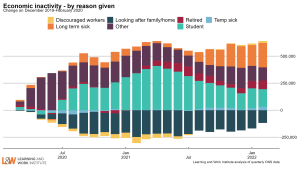
In the recent ONS survey of older adults who have recently left work, 59% of the sample said they would not consider returning to work, 39% said they would consider returning to paid work in the future.
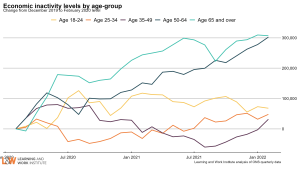
In addition, the number of people claiming unemployment-related benefits remains 407,600 above the survey measure of unemployment, despite a fall of 46,900 in March 2022 compared to the previous month. It is important that Jobcentre Plus engage with everyone on out-of-work benefits to ensure their status is recorded correctly and everyone who wants to work gets help to find a job.

4. Long-term unemployment appears to have peaked for both young people and adults, but remains higher than pre-pandemic for those aged 25+
Long-term unemployment is a particular concern as it reduces people’s chances of finding work and can reduce their health and wellbeing.
Long-term unemployment rose significantly through the pandemic. It has fallen recently for young people and is now 9,000 lower than pre-pandemic. There are 74,000 more people aged 25 and over out of work for 12 months or more than before the pandemic (Dec 19-Feb 20), though this is now falling (either due to people finding work or moving into economic inactivity).
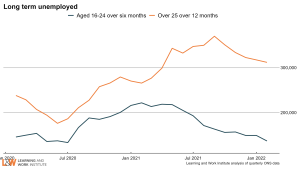
There are 909,000 (13.4%) young people not in employment or full-time education, up on the lows seen in summer 2021 but down on pre-pandemic levels. Overall, student jobs have been opening up, showing a rise of 26% in young people in education taking up work since last year, but more analysis is needed on young people becoming inactive. Support for young people remains too disjointed and a Youth Guarantee is needed to offer all 16-24 year olds a job, training place or apprenticeship.
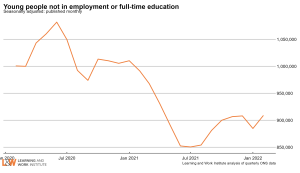
5. The number of people claiming benefits has risen most in big cities
The relative change in the claimant count by Local Authority area since March 2020 shows a tale of big cities and areas with airports faring badly compared with the rest of the UK. Cities overall have worsened, with far higher numbers of people claiming benefits since the start of the pandemic, and some areas have declined from a poor starting position, such as the West Midlands. Areas such as Local Authorities in the North East, however, have seen a much lower rise in the number of people claiming benefits since the start of the . Note that, while the claimant count is only telling a partial picture, the relative trends over time can help to illustrate the local labour market picture.
